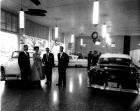|
Re: Gas tank fuel sender repair.
|
||||
|---|---|---|---|---|
|
Webmaster
|
Dave, I agree with you! That was the point I was trying to get across. You are not dealing with a pressure fed line, rather a line under a vaccum. So I dont see any danger in a compression fitting.
Posted on: 2008/10/16 20:06
|
|||
|
-BigKev
1954 Packard Clipper Deluxe Touring Sedan -> Registry | Project Blog 1937 Packard 115-C Convertible Coupe -> Registry | Project Blog |
||||
|
||||
|
Re: Gas tank fuel sender repair.
|
||||
|---|---|---|---|---|
|
Webmaster
|
How is the oil fed to the furnace? Is there a pump sucking the oil in at the furnace? or is it gravity fed? If it's gravity fed, then there is pressure on the line.
But more the point I was trying to make is that on a vacuum drawn fuel line (which is what it is when the pump is up near the engine), that if a compression fitting failed, or flarred fitting, or the line itself, then the it may leak a tiny amount of gas for a couple of seconds. But most of the fuel would drain back to the tank as air is sucked in a the point of failure. But on a line that is either pumped from the source (tank mounted), or gravity feed, then if the line or fitting failed then it would continue to leak fuel (gas, oil, etc) at that point until the pump was turned off, or it ran out of fuel (in a gravity feed system).
Posted on: 2008/10/16 21:08
|
|||
|
-BigKev
1954 Packard Clipper Deluxe Touring Sedan -> Registry | Project Blog 1937 Packard 115-C Convertible Coupe -> Registry | Project Blog |
||||
|
||||
|
Re: Gas tank fuel sender repair.
|
||||
|---|---|---|---|---|
|
Forum Ambassador

|
John, my last words on the subject. I just checked the Parker catalog for specifications on brass compression gland fittings; depending on style, tubing, etc. they come rated for service as high as 2800 psi, thus they can surely handle the suction side of a fuel line, an oil furnace line (that's what mine has) and the pressure side of an carburetor fuel line which is typically 4 -6 psi.
Posted on: 2008/10/17 8:49
|
|||
|
||||
|
Re: Gas tank fuel sender repair.
|
||||
|---|---|---|---|---|
|
Forum Ambassador

|
Well I got the new line wound around the engine compartment by removing the driver side front wheel, the generator and the lower inner fender panel. I was able to get my tube bender inside and to bend the tubing around the shock absorber. The section that follows the curve of the rad was easy and done by hand. The only problem is still to get the line to bend sharply where it connects to the brass fitting. I crimped the line with the bender trying to make what is a sharp turn in the line. I still might have enough spare play to try this again and if not I may have to resort to a using another fitting to join the two. I have a tube end flaring tool that does the double flare and may be able to work it while under the car otherwise a compression fitting will do as well so I am pleased I have choices. I will keep you posted and thanks for the thoughts and opinions.
Posted on: 2008/10/17 11:29
|
|||
|
||||
|
Re: Gas tank fuel sender repair.
|
||||
|---|---|---|---|---|
|
Forum Ambassador

|
A bit curious why you had to do this job, I guess the original fuel line failed? Physical damage or rust-thru? Guess I'm lucky, both my cars still have the original fuel lines; I've vacuum-checked them from time to time, given them occasional visual checks, and before the era of ethanol in gas, I used dry gas with some frequency. Yet the bigger reason may be that the cars have been continuously in service, never laid up, and always with good storage. My luck with hydraulic brake lines hasn't been as good though, plus of course stopping can be seen as more important that going.
Posted on: 2008/10/17 12:07
|
|||
|
||||
|
Re: Gas tank fuel sender repair.
|
||||
|---|---|---|---|---|
|
Forum Ambassador
|
Hats off for getting as far as you have. I'd have taken the front end off--but then I usually do it the hard way at least twice before wising up.
Posted on: 2008/10/17 12:35
|
|||
|
||||
|
Re: Gas tank fuel sender repair.
|
||||
|---|---|---|---|---|
|
Forum Ambassador

|
As my wife says (and I never seem to learn) "If it ain't broke don't fix it". There was no leak or rust through issues with the original line and the car was stored away long before salt was used on the roads in winter. The car was stored, but poorly, for about 50 years. The line looked pretty crappy though from age and winter weather and was pretty rusty on the outside. Additionally the line was crushed where it passed over the frame and I figured that it might be restricting gas flow. I must admit however that being bored and needing something to do was probably the main motivation. Sometimes I should listen more to my wife.

Posted on: 2008/10/17 12:41
|
|||
|
||||









